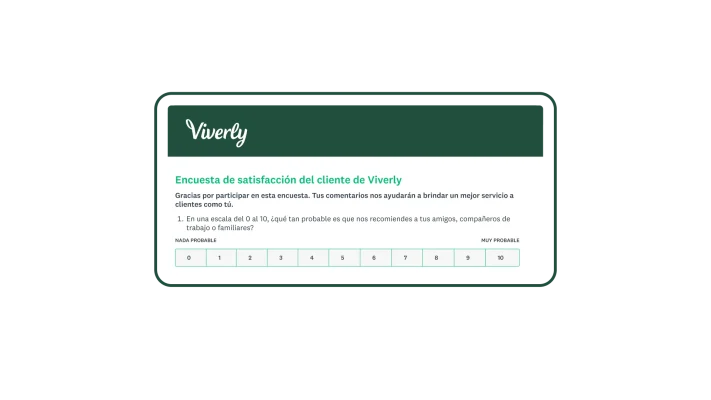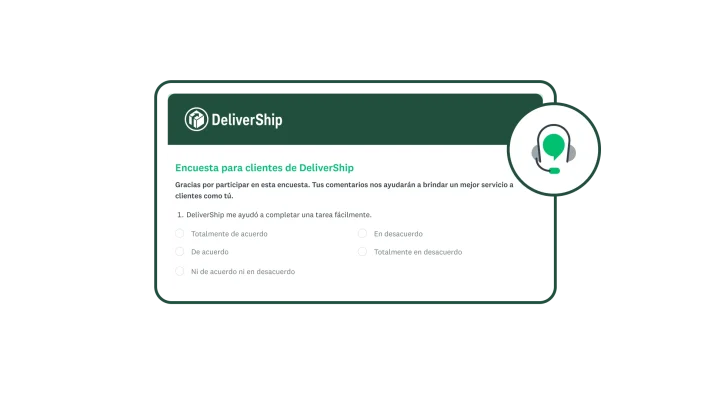Cómo crear un programa de voz del cliente exitoso

¿Cuándo fue la última vez que evitaste una marca por algo que escuchaste o que dejaste de comprarle a una empresa que te decepcionó?
¿Con qué frecuencia te comunicas con esas empresas para decirles por qué no les comprarías?
Si estás a cargo de mejorar la experiencia del cliente (CX), no puedes esperar que los consumidores vengan a ti por iniciativa propia. En lugar de eso, debes iniciar la conversación, y defender, implementar y mantener tu propio programa de voz del cliente en tu organización.
¿Qué es un programa de voz del cliente?
Definición de voz del cliente: Se refiere a la recopilación, el análisis y el monitoreo sistemático de las interacciones del cliente con tu producto, servicio o marca.
Tener un programa de voz del cliente es de vital importancia para mejorar la experiencia general de los clientes (CX). En esencia, es un compromiso de tomar medidas basadas en la retroalimentación de los clientes. Tu objetivo inicial consiste en reducir la distancia entre las expectativas del cliente y el desempeño de tu organización. Al mantener un programa de voz del cliente eficaz, también les das a tus empleados las herramientas que necesitan para superar las expectativas de los clientes.
La diferencia entre crear un programa de voz del cliente y obtener retroalimentación de los clientes
Muchas organizaciones solicitan retroalimentación a los clientes a través de encuestas, formularios de opinión y grupos de enfoque, pero un programa de voz del cliente no es solo la recopilación de comentarios. Cuando creas un programa de voz del cliente para tu negocio, estás haciendo que el compromiso, la lealtad y la satisfacción del cliente sean una parte central de tu estrategia comercial. Un buen programa de voz del cliente incluye:
- Objetivos comerciales concretos
- Apoyo del equipo de liderazgo
- Participación y colaboración de los empleados
- Una comprensión integral de la trayectoria del cliente
- Escucha proactiva del cliente en todos los canales y puntos de contacto
- Investigación periódica de clientes y del mercado
- Análisis de datos e informes
- Comunicación interna
Lo más importante de un buen programa de voz del cliente es que se pueda poner en práctica. Una de las prioridades de las empresas es cerrar el ciclo de retroalimentación de los clientes mediante la identificación de puntos problemáticos, la resolución de problemas y la comunicación de los cambios tanto a los empleados como a los clientes.
Continúa leyendo para aprender a crear tu propio programa de voz del cliente, desde la planificación hasta la implementación y el mantenimiento. Verás consejos, indicadores clave de voz del cliente y recursos como estas plantillas de encuestas de voz del cliente para que puedas comenzar de forma sencilla.
Crea tu programa de voz del cliente
1. Gana la aceptación y el apoyo del equipo de liderazgo
Diseñar un programa de voz del cliente, o incluso actualizar uno que ya tienes, requiere tiempo y recursos. Antes de empezar a elaborar un plan completo, recopila la siguiente información y preséntala a los líderes para asegurarte de que todos estén de acuerdo:
- Los principales puntos problemáticos de los clientes o indicadores preocupantes (como un aumento interanual del 5 % en la pérdida de clientes).
- Qué es un programa de voz del cliente o cómo crees que podría mejorar tu programa de voz del cliente actual.
- Algunos casos de estudio de otras empresas muestran lo importante que es priorizar la escucha activa de los clientes y tomar medidas. Como cuando la compañía de autobuses Greyhound aumentó un indicador clave de lealtad del cliente en 15 puntos e hizo cambios cruciales en la experiencia de sus clientes, lo cual tuvo un impacto en su rentabilidad.
2. Trabaja con los colaboradores clave para establecer objetivos
Una vez que tengas a los líderes a bordo, colabora con diferentes equipos de toda la empresa. Cada parte interesada tendrá una perspectiva única sobre la experiencia del cliente, así como diferentes formas de mejorarla.
- Los equipos de Éxito del cliente y de Servicio al cliente trabajan directamente con ellos, por lo que comprenden los principales puntos problemáticos y las quejas relacionadas con tu producto o servicio.
- Marketing y Comunicaciones tienen sus propios puntos de vista sobre la competencia y el mercado. También se comunican con los consumidores directamente a través de las redes sociales.
- El departamento de Ventas tiene una perspectiva sobre la sensibilidad al precio, los productos y las soluciones de la competencia, así como qué mensajes funcionan (o no) con los clientes potenciales.
- Los equipos de Producto pueden ayudarte a comprender cómo las personas interactúan con tu producto o servicio, lo cual incluye datos como los índices de abandono o errores. También pueden explicarte cómo funcionan los productos y cualquier problema o error que pudiera estar afectando la satisfacción del cliente.
- Recursos Humanos u Operaciones del personal pueden hablar de la experiencia de los empleados. ¿Están comprometidos? ¿Se sienten capacitados para generar un impacto positivo en la experiencia del cliente?
Cada uno de estos equipos puede tener diferentes objetivos o ideas sobre el éxito. Para empezar, puedes elegir un objetivo para toda la empresa (por ejemplo, “mejorar nuestro índice de satisfacción del cliente en un 10 %”) y animar a cada equipo a establecer su propio objetivo.
Solo recuerda que esta es una iniciativa centrada en el cliente. Por ejemplo, el equipo de Producto podría querer mejorar una experiencia de incorporación de clientes para aumentar las suscripciones, pero en el contexto de un programa de voz del cliente, sería mejor que tus equipos de Producto y de Servicio al cliente trabajaran juntos. En este caso, el equipo de Servicio al cliente podría señalar los principales puntos problemáticos con la experiencia de incorporación, y el equipo de Producto podría abordarlos con el objetivo de reducir la cantidad de tickets de servicio al cliente.
3. Crea un mapa de la trayectoria del cliente
Reúnete con los colaboradores clave para analizar cómo interactúa un cliente (o posible cliente) con tu marca antes, durante y después de la compra. Esto se denomina mapeo de la trayectoria del cliente y puede ayudarte a identificar oportunidades para obtener retroalimentación, entender mejor un punto de contacto específico o llenar cualquier vacío en la experiencia del cliente. Los puntos de contacto comunes con el cliente ocurren antes, durante y después de una compra. Algunos ejemplos incluyen:
- Antes de la compra: publicidad, recomendaciones de boca en boca, redes sociales
- Durante la compra: sitio web, tienda, punto de venta
- Después de la compra: facturación, correos electrónicos de transacciones, centro de asistencia en línea
Al crear un mapa de la trayectoria del cliente, también debes tener en cuenta cuándo, dónde y con qué frecuencia solicitas retroalimentación de los clientes. Esto te ayudará a perfeccionar tus encuestas, a planificarlas y darles seguimiento de manera más eficaz.
¿Necesitas ayuda para crear un mapa de la trayectoria del cliente?
Aprende a crear un mapa de la trayectoria del cliente para coordinar a los colaboradores clave y lograr tus objetivos comerciales.
4. Escucha a los clientes de forma constante
Cuando escuchas a tus clientes, recopilas retroalimentación estructurada y no estructurada (datos cuantitativos y cualitativos) de la voz del cliente.
Los datos estructurados son cuantificables o medibles. Por ejemplo, al enviar una encuesta en la que pides a los clientes que califiquen la probabilidad de que vuelvan a comprar en tu negocio. Como quieres que elijan entre un conjunto de opciones, los resultados tienen un valor numérico: el 76 % de los clientes dicen que volverían a comprar tu producto.
Los datos no estructurados son cualitativos o no medibles. En el caso de la encuesta sobre la experiencia de compra, le pides a alguien que explique por qué es “muy probable” que vuelva a comprar en tu negocio. Aquí incluyes un cuadro de texto para que pueda contarte más al respecto. Las respuestas de texto que recibes te ayudarán a comprender el porqué detrás de los números.
Para obtener un panorama completo de la experiencia de tus clientes, es recomendable recopilar ambos tipos de datos. A continuación se muestran diferentes maneras en las que puedes escuchar de forma periódica a tus clientes como parte de un programa eficaz de voz del cliente:
- Asegúrate de obtener retroalimentación mediante encuestas de satisfacción del cliente en puntos clave de contacto con el cliente, como después de una compra o una interacción con el servicio al cliente.
- Alienta a los equipos de toda la empresa a reunirse con equipos como Ventas y Servicio al cliente una vez por trimestre.
- Realiza investigaciones periódicas con clientes o usuarios para obtener percepciones sobre tu posición frente a la competencia y detectar áreas de mejora para tu producto o servicio.
- Realiza grupos de enfoque y entrevistas con clientes para obtener percepciones detalladas.
- Practica la escucha social para saber cómo la gente percibe tu marca.
5. Usa indicadores clave sobre la voz del cliente
Existen algunos indicadores de voz del cliente estándar de la industria que las empresas utilizan para comprender la experiencia del cliente. Te presentamos tres de los indicadores de voz del cliente más populares:
Índice Net Promoter Score (NPS)

¿Qué tan probable es que alguien recomiende tu empresa a amigos, compañeros de trabajo o familiares? La encuesta Net Promoter Score® (NPS) te ofrece una respuesta cuantificable que puedes monitorear fácilmente. Esta es una descripción general de la encuesta de NPS:
- Cálculo del NPS simple: Los encuestados dan una calificación de 0 a 10 y la puntuación resultante es un número de -100 a +100.
- Seguimiento fácil y conveniente: La pregunta del Net Promoter Score es simple y versátil, puedes usarla para saber si alguien recomendaría tu marca, o tu aplicación o software. La pregunta de NPS no está vinculada a ningún evento específico, por lo que es un buen indicador del desempeño de tu organización en cualquier momento.
- Puntos de referencia útiles de la industria: Como muchas organizaciones utilizan el NPS, puedes comparar tus acciones con las de otras empresas de tu sector industrial. Por ejemplo, nuestro análisis de cientos de encuestas de NPS muestra que 38 es la puntuación promedio para la industria de la salud.
Puntuación de satisfacción del cliente (CSAT)

Mientras que el NPS refleja la lealtad del cliente a lo largo del tiempo, la puntuación de satisfacción del cliente (CSAT) te ayuda a comprender cómo se siente un cliente después de una interacción específica con tu marca. Esto es lo que debes saber sobre la encuesta de CSAT:
- Funciona bien con el NPS: Tanto la CSAT como el NPS son importantes indicadores de la voz del cliente y brindan información diferente y complementaria sobre la experiencia del cliente.
- Es específica y práctica: Utiliza encuestas de CSAT para realizar mejoras específicas en la experiencia de tus clientes. Puedes obtener retroalimentación sobre el servicio al cliente o medir la satisfacción de los asistentes con sus comentarios sobre un evento.
- Es fácil de calcular y analizar: Las opciones de respuesta en una encuesta de CSAT se basan en una escala numérica, por ejemplo, del 1 al 5. Puedes observar los datos sin procesar, como “478 clientes dijeron que estaban 'muy satisfechos' con su reciente interacción con el servicio al cliente”. O puedes ver los datos como un porcentaje.
Indicador de esfuerzo del cliente (CES)

¿Qué tan fácil o difícil les resulta a los clientes realizar tareas específicas al interactuar con tu empresa? El indicador de esfuerzo del cliente (CES) te ayuda a identificar los principales puntos de fricción de los clientes, como al utilizar tu software o intentar resolver un problema específico. Estos son algunos de los motivos por los que deberías utilizar las encuestas de CES para tu programa de voz del cliente:
- Aumenta la lealtad del cliente: Según nuestras investigaciones, el 91 % de los consumidores están más dispuestos a recomendar una empresa si tienen una experiencia que requiere poco esfuerzo.
- Encuentra formas rápidas de mejorar: Un mensaje poco claro puede ser suficiente para que los clientes abandonen una compra. ¿Qué impacto habría en tus resultados si modificaras algunas palabras en el proceso de pago?
- Crea mejores programas de capacitación: Puedes usar encuestas de CES para identificar áreas de mejora en tu equipo de Servicio al cliente, por ejemplo, si los representantes demoran demasiado en resolver problemas. Cuando conoces las dificultades de tus clientes, puedes personalizar la capacitación de tu equipo de Servicio al cliente para resolver problemas comunes más rápido.
6. Analiza los resultados
Una vez que comiences a obtener retroalimentación de los clientes en todos los puntos de contacto, debes examinar cada conjunto de datos y comparar tus hallazgos.
- Pide a tus socios de otros departamentos que compartan las percepciones que hayan recopilado en investigaciones de mercado y de clientes, canales de redes sociales, etc. Es recomendable tener toda esta información en un solo lugar, como una wiki interna o un sitio web.
- Algunos datos, como tu Net Promoter Score, se pueden comprender fácilmente a nivel general. Pero si recopilas comentarios abiertos en las encuestas de tus clientes, utiliza una herramienta de análisis de texto para descubrir tendencias ocultas.
- Segmenta los datos de tu encuesta con herramientas de análisis avanzadas, como filtros de datos personalizados, que pueden enriquecer los resultados con percepciones más profundas de los clientes.
7. Implementa, mantén y repite el proceso
Una vez que determines tu estrategia para escuchar al cliente, presta atención y aborda cualquier problema inmediato, como una disminución del NPS o una baja puntuación de satisfacción del cliente.
A largo plazo, necesitas crear un marco para mantener un programa de voz del cliente sólido para tu organización. Te compartimos algunas ideas:
- Influye en las hojas de ruta de los productos: Los equipos de Producto pueden comprometerse a solucionar uno o dos problemas urgentes de los clientes una vez por trimestre.
- Mejora la capacitación y la respuesta del servicio al cliente: Los equipos de Servicio el cliente pueden centrarse en mejorar el proceso de incorporación de los empleados y capacitarlos para mostrar empatía. También pueden crear plantillas de respuestas útiles para las preguntas más frecuentes de los clientes, a fin de reducir el tiempo de respuesta.
- Involucra a toda la empresa: Dedica una o dos semanas cada semestre para enfocarte en resolver problemas de los clientes o responder a retroalimentación clave.
- Pon a los clientes en el centro de tu negocio: Invita regularmente a los clientes a contar sus historias a los empleados.
- Comparte los logros y áreas de mejora: Considera enviar un informe mensual a la empresa en el que se destaque la retroalimentación clave, tendencias de datos e historias de clientes que motiven a los empleados.
Ventajas de los programas de voz del cliente
Como es de esperar, cuando tus clientes están contentos, es más probable que sean leales a tu marca y la recomienden a otras personas, pero un programa de voz del cliente tiene otras ventajas que quizás no son tan evidentes.
Mejora el compromiso de los empleados
Al crear un programa de voz del cliente, estás capacitando a los empleados para que tengan un impacto directo en la experiencia de tus clientes. Incluso puedes animar a los equipos a establecer objetivos centrados en el cliente y recompensarlos por sus logros.
Obtén una ventaja competitiva
Gran parte de la recopilación de retroalimentación es reactiva, por lo que solo puedes comprender cómo se sienten los clientes después de interactuar con tu marca. Un programa de voz del cliente también se ocupa de la recopilación proactiva de opiniones. A través de grupos de enfoque, entrevistas con clientes, escucha activa en las redes sociales e investigaciones de usuarios puedes encontrar oportunidades para desarrollar nuevas ideas de productos, resolver los problemas de los consumidores y mucho más.
Obtén aún más testimonios de clientes y recomendaciones en redes sociales
Puedes utilizar interacciones y comentarios positivos de los clientes para contar historias poderosas sobre tu marca en todos los canales, desde material de marketing hasta tu sitio web y plataformas de redes sociales.
Estrategias para superar los desafíos comunes de los programas de voz del cliente
Desafío N.º 1: La retroalimentación y los datos de los clientes están aislados
Datos como las investigaciones de mercado, las percepciones de los usuarios, la retroalimentación sobre el servicio al cliente, las interacciones en las redes sociales y los resultados de encuestas funcionan en conjunto para brindar un panorama completo de la experiencia de tu cliente. Si los datos están aislados, es difícil captar las tendencias y detectar oportunidades importantes para que los equipos de toda tu organización puedan actuar.
Haz que cada equipo o colaborador clave sea responsable de informar sobre sus hallazgos o de compartirlos todos en un solo lugar. Puedes simplificar la recopilación y gestión de comentarios con las integraciones de encuestas para Salesforce, HubSpot, Mailchimp, Zendesk, Zoom, entre otras.
Desafío N.º 2: Los clientes no responden encuestas de opinión
¿Envías encuestas pero no recibes suficientes respuestas para obtener resultados estadísticamente significativos? Como parte de tu programa de voz del cliente, considera realizar una auditoría de encuestas y pasar cada una por una lista de verificación de prácticas recomendadas.
Si tus encuestas son demasiado largas o confusas, es posible que los clientes las ignoren. Para obtener más respuestas, te recomendamos utilizar plantillas de encuestas escritas por expertos y preguntas de encuestas de satisfacción del cliente.
¿Sigues sin saber por qué tus encuestas no están dando resultados? Estos consejos para aumentar las tasas de respuesta de CSAT y las prácticas recomendadas para redactar preguntas de encuesta de CSAT pueden resultarte útiles.
Desafío N.º 3: Ciertos equipos no están interesados en colaborar
Si la idea de mantener a los clientes contentos no es suficiente para motivar a los equipos a priorizar la resolución de los problemas, debes vincular la satisfacción del cliente con los ingresos. Por ejemplo, puedes mostrar el cambio en el RSI al mejorar la satisfacción del cliente relacionando el valor a largo plazo de un cliente retenido con la cantidad de personas dispuestas a volver a comprar.
Comparte investigaciones convincentes con los equipos reacios para construir un argumento sólido. Nuestra investigación muestra que el 75 % de los clientes pierden la confianza en una empresa después de una mala experiencia con un producto, entre otros hallazgos importantes.
5 prácticas recomendadas para crear el programa de voz del cliente
Diseña un programa de voz del cliente que te permita medir el sentimiento de tus clientes de forma constante. Sigue estas prácticas recomendadas para involucrar a tus clientes en un diálogo, alinear a los colaboradores clave de tu empresa y crear cambios que generen un impacto:
- Presta atención a los datos implícitos. Los datos implícitos, como el uso de aplicaciones o el índice de abandono, son lo opuesto a los comentarios explícitos de los clientes. Un cliente puede decirte que está satisfecho con tu aplicación, pero si no la vuelve a usar, es hora de hacer más preguntas.
- Antes de comenzar con el análisis de datos, limpia los datos de tu encuesta para obtener resultados más precisos con los que puedas actuar.
- Lo más probable es que cuanto más contentos estén tus empleados, mejor será la experiencia del cliente. Trabaja con Recursos Humanos u Operaciones del personal para monitorear el compromiso de los empleados y su satisfacción, por ejemplo, mediante una encuesta de eNPS. Incluso puedes monitorear y dar seguimiento a indicadores cruciales de compromiso de los empleados, como el NPS de los empleados, y compararlos con el NPS de tus clientes.
- Pon tus resultados en contexto. Desde luego, ya estás monitoreando la satisfacción de tus clientes a lo largo del tiempo. Pero también debes comparar tus resultados con los de la competencia para tener una idea real de tu desempeño.
- Asegúrate de que tu programa de voz del cliente esté actualizado. Infórmate sobre las principales tendencias en la experiencia del cliente, como la manera en que los profesionales de CX están enfrentando los retos de la IA y adaptándose a las cambiantes expectativas de los consumidores.
Comienza a desarrollar tu programa de voz del cliente hoy
Envía una encuesta en minutos con una de estas plantillas de encuestas de la voz del cliente diseñadas por expertos. Si necesitas ayuda adicional, descubre cómo SurveyMonkey puede impulsar tu programa de voz del cliente.
Net Promoter, Net Promoter Score y NPS son marcas comerciales registradas de Satmetrix Systems, Inc., Bain & Company, Inc. y Fred Reichheld.
Descubre más recursos

Plantilla de encuesta sobre la satisfacción de los clientes
Explora las plantillas de encuestas de satisfacción del cliente y recopila datos con rapidez, identifica puntos problemáticos y mejora su experiencia.

Conoce cómo Ryanair recopila percepciones de los clientes a escala
Ryanair utiliza la integración de SurveyMonkey con Microsoft Power BI para hacer un seguimiento de las encuestas mensuales de CSAT y mejorar la CX.

Ve cómo Woom mejora la experiencia de sus empleados y clientes
Descubre cómo Woom usa SurveyMonkey para lanzar encuestas en varios idiomas, mejorar la experiencia de empleados y obtener percepciones sobre clientes.

3 tendencias en el lugar de trabajo que transformarán la fuerza laboral actual
Nueva investigación sobre las tendencias laborales y cómo los empleados equilibran su tiempo personal, el trabajo remoto y en la oficina